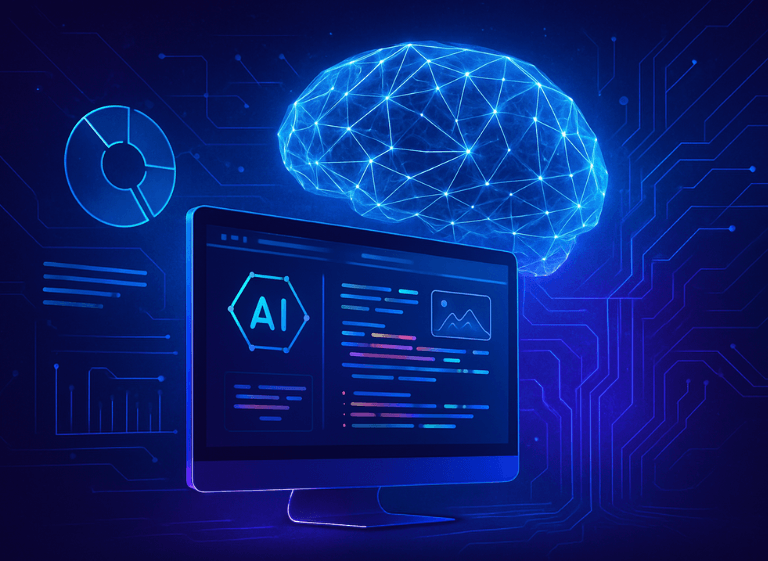Web Development
AI tools
Product strategy
Real project examples
The Truth About Using Generative AI in Web Development Today
Nadiia Sidenko
2025-05-02
Generative AI is reshaping web development by enabling real-time personalization, smarter support systems, and automated content generation — but not every integration leads to success. Many digital products implement it without understanding its real limitations or business fit. This article explores what generative AI can truly deliver, where it often fails, and how to decide whether it’s the right move for your web product.

What Is Generative AI and Why It Matters in Web Development
Generative AI refers to models that can produce content — text, images, code, and more — based on training data and user input. Unlike traditional machine learning systems, which typically classify or predict outcomes, generative models create entirely new content grounded in learned patterns.
While traditional AI might predict user churn or classify support tickets, generative AI can write the ticket response itself, design a new landing page layout, or draft product descriptions. That’s why it’s reshaping how we build and scale user-centric features in web applications.
The implications for web development are broad. With generative AI, teams can now automate UX personalization, streamline backend logic creation, and optimize user flows through data-informed content generation.
As a foundation, understanding core web development fundamentals is crucial — only then does it make sense to layer in intelligent automation.
Use Cases of Generative AI in SaaS, EdTech, and Retail
Generative AI's potential becomes clearer when we examine its role across specific industries. From SaaS dashboards to EdTech tools and dynamic e-commerce platforms, businesses are applying it in powerful ways.
Let’s explore some of the most common implementations.
AI-Powered Chatbots and Support Systems
Forget basic scripted bots. Today’s AI-driven assistants can understand user context, summarize conversations, and escalate issues with human-like clarity. For SaaS platforms, this translates into reduced support loads and better customer satisfaction. In EdTech, AI tutors help students navigate content dynamically.
Personalized Content Generation and Recommendations
Generative AI shines in personalizing at scale. Whether it’s tailoring lesson plans for learners or adapting marketing emails for shoppers, AI delivers what static logic can’t. In retail, for example, smart engines build individual user journeys, generating unique messages based on behavior patterns.
This is especially evident in shopping apps, where AI adjusts product feeds and promotions on the fly, driving better conversions.
Code Generation and Developer Productivity
Beyond UX, generative tools like GitHub Copilot are speeding up development cycles. Developers can autocomplete functions, generate test cases, or even scaffold new modules, cutting iteration time significantly. It’s not about replacing coders — it’s about giving them superpowers.
Case Study: How Opps Used OpenAI to Improve Recommendations
While theory is valuable, real-world execution reveals the full picture. One of our recent client projects, Opps, involved building an AI-powered platform for data-driven marketing. The platform helps startups and businesses discover verified leads, analyze audience segments, and identify potential investors through intelligent data extraction and automated targeting.
To achieve this, the Pinta WebWare team developed a modern frontend using React, implemented a scalable backend with NestJS, and integrated OpenAI to power real-time personalized recommendations. By analyzing behavioral patterns and contextual signals, the system could generate high-relevance suggestions across the platform.
Initial Business Goal and User Problems
Opps needed a smarter way to connect users with the right opportunities. Its earlier logic-based system didn’t adapt to behavioral changes or evolving market signals, which led to low engagement and inefficient targeting.
Why We Chose OpenAI and How It Was Integrated
After reviewing multiple model options, OpenAI’s GPT offered the best balance of flexibility, quality, and integration simplicity. It was used to evaluate user behavior and deliver personalized suggestions on the fly, dramatically improving lead relevance and campaign outcomes.
Why We Chose OpenAI and How It Was Integrated
Engagement metrics improved significantly within weeks. Time-on-platform increased, and Opps reported a 21% lift in retention. However, we had to address latency concerns and implement content filters to maintain brand tone and accuracy.
The key lesson? Generative AI works best when it’s paired with domain knowledge, well-defined prompts, and thoughtful implementation — not just plugged in blindly.
Top Benefits of Using Generative AI in Web Products
When implemented thoughtfully, generative AI adds tangible business value beyond surface-level automation. Here are some of the top advantages.
Enhanced Personalization at Scale
Manual personalization is costly. With AI, product content, navigation paths, and promotions can adapt dynamically per user — at scale. This leads to higher engagement and more meaningful user experiences.
Faster Prototyping and Testing
Need to test multiple landing pages or UX flows? AI can generate variations in seconds, helping product teams validate hypotheses faster without overloading design or dev resources.
Cost Efficiency in Content and UX Design
Content creation is often a bottleneck. Generative tools reduce the time and cost of drafting, localizing, and adapting assets. Marketing, product, and UX teams all benefit from reduced creative overhead.
Cost Efficiency in Content and UX Design
For every success story, there’s an overengineered failure. Generative AI isn’t magic — and expecting it to “just work” is a recipe for trouble.
Overpromising Features to Stakeholders
PMs often oversell what AI can do. This creates misalignment between teams and sets the stage for disappointment. AI isn’t an all-knowing oracle — it still needs tuning and boundaries.
Misaligned User Expectations and Outcomes
If users expect perfection, they’ll notice every odd sentence or misplaced recommendation. Without proper UX scaffolding, AI-driven features can feel erratic or uncanny.
Model Hallucination and Content Inaccuracy
AI is known to fabricate facts — especially without strong prompt constraints. If left unchecked, this leads to misinformation or brand inconsistency.
This echoes what we discussed in why ad campaigns fail without UX and CRO — the tech may be strong, but poor execution sinks the product.
How to Evaluate and Select the Right AI Solution
Before integrating any model, teams should critically assess their options and limitations.
OpenAI vs Open Source Models: What to Consider
OpenAI offers convenience and power, but open-source options like LLaMA or Mistral can be fine-tuned in-house. It’s a trade-off between control, cost, and performance.
Latency, Cost, Privacy: Questions You Must Ask
- Will real-time generation slow down your product?
- What are the monthly token costs under actual usage?
- Is your data secure when using third-party APIs?
These aren’t just technical concerns — they impact your product strategy.
When Not to Use Generative AI at All
If your value proposition doesn’t require variability, AI might be overkill. Static content, low user volume, or high regulatory risk can make traditional logic more efficient and reliable.
Comparing Generative AI Options: Key Evaluation Criteria
| Criteria | OpenAI (e.g., GPT-4) | Open Source (e.g., LLaMA, Mistral) |
|---|---|---|
| Ease of Integration | Plug-and-play API, fast setup | Requires custom deployment and infrastructure |
| Cost Transparency | Pay-per-token with clear usage metrics | Variable; depends on hosting, maintenance, tuning |
| Data Privacy | Data processed externally (unless self-hosted) | Full control over data if hosted in-house |
| Customization | Limited, mostly through prompt engineering | Full fine-tuning available |
| Latency Control | May vary depending on server load/API response | More predictable if self-optimized |
| Regulatory Fit | Needs due diligence for compliance | Easier to adapt to industry-specific requirements |
| Maintenance | Offloaded to provider | Fully your responsibility |

Should You Add Generative AI to Your Web Product?
Generative AI isn’t just a trend — but it’s not a fit for everyone either. If your product depends on personalization, automation, or content generation, the potential is worth exploring. But to make it work, you’ll need clarity, resources, and expertise.
Sometimes, the hardest part is recognizing when AI truly adds value — and when it simply adds complexity.
A trusted partner with real-world experience — like Pinta WebWare, which has delivered AI-driven solutions across SaaS, EdTech, and e-commerce — can help you navigate that decision with confidence.